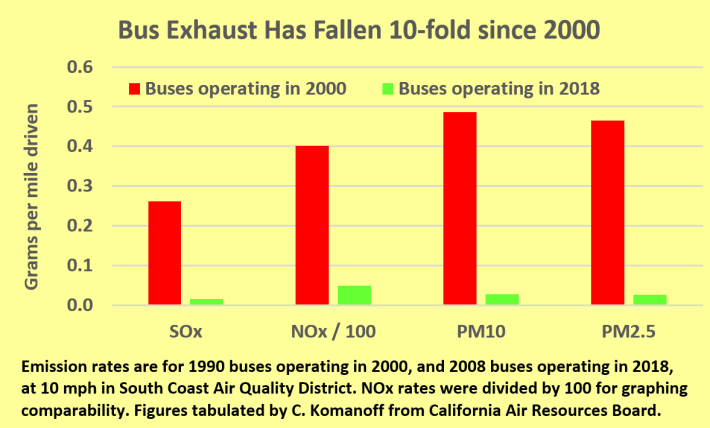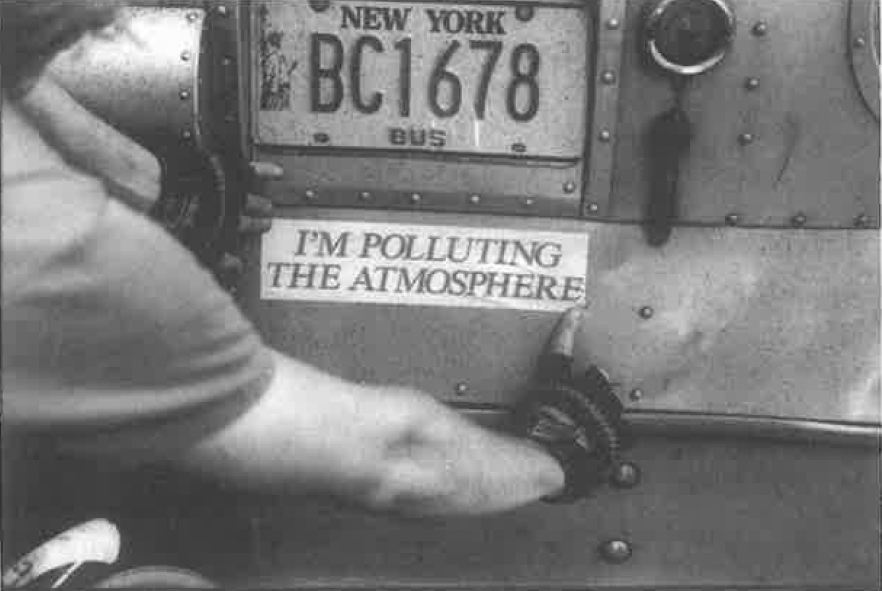Getting blasted by exhaust from a NYC Transit bus used to be standard fare when traversing city streets by foot or bike. Not lately, though.
Along with myriad other changes in tailpipes and smokestacks that have vastly improved NYC’s air quality since Earth Day 1970, the cleanup of the city’s diesel buses is rarely remarked on. But the impact is palpable. Though historic inequities persist in the distribution of clean air, just about every corner of the city today enjoys clearer skies and easier breathing than decades ago.
Old notions die hard, however, especially where buses are concerned, and particularly when downgrading driving and ride-hailing in favor of bus transit is on the agenda, as in the joint MTA-DOT proposal for the pending L train shutdown. So it was no surprise that when a temporary 14th Street busway was discussed at a town hall meeting in Greenwich Village last week, NYC Transit president Andy Byford was asked, “[W]hat are you going to do about the pollution, not only to my health but to the health of our beautiful buildings.”
Byford’s interrogator, Michele Golden, is a litigant in the lawsuit filed last moth by attorney Arthur Schwartz that seeks to sidetrack the 14th Street busway as well as a proposed 13th Street bikeway. (Ironically, the lawsuit raises the specter of the “heightened levels of pollution ... from idling cars, for-hire vehicles and trucks” that MTA and DOT hope to mitigate by enhancing bus and bike infrastructure.)
As reported by Gothamist, Byford admitted that NYC Transit’s forthcoming three-year electric bus pilot program will start too late for 14th Street. Of 200 new MTA buses being added for the shutdown plan, only 15 will be electric, with the remainder mostly “clean diesel.”

I’ll grant that the massive Volkswagen emissions cheating scandal (which concerned diesel autos, not buses) can make it tricky to champion clean diesels. Nevertheless, instead of haplessly referencing the too-late electrics, Byford could have pointed to the dramatic reductions in emissions from NYC Transit’s entire fleet of 4,000 diesel buses.
Some history: throughout the second half of the 20th century, the diesel fuel burned in buses had a sulfur content of 2,000 parts per million. The resulting sulfur-laced exhaust corroded not only human lungs but also engine filters intended to trap toxic particulate emissions. That finally changed early in this century, after a sustained campaign by the Natural Resources Defense Council to “Dump Dirty Diesels” forced refiners to cut diesel fuel’s sulfur content more than a hundred-fold, to just 15 parts per million. The change has enabled urban bus fleets across America to drastically reduce emissions of SO2 and particulates while also cutting harmful nitrogen oxides (the engines burn cooler which limits oxidation of nitrogen).
I wasn’t able to get NYCT to quantify its bus emission reductions in time for this post, so I did the next best thing: I downloaded the California Air Resources Board’s gold-standard EMFAC (EMission FACtor) model and looked up emission rates for 2000 and 2018 for 10-year-old urban buses running at average speeds of 10 mph. The results were stark: compared to 2000, buses today are emitting 94 percent less particulate matter and sulfur dioxide, and 88 percent less nitrogen oxides. Though meteorological and traffic differences add some uncertainty to the extrapolation from Southern California to New York, these findings corroborate that transit bus emissions on our streets have fallen enormously.
New Yorkers dreading an invasion of soot-belching buses during the L train shutdown should literally take a deep breath. Their lungs will do fine. The rest of us will heave a sigh of relief.






